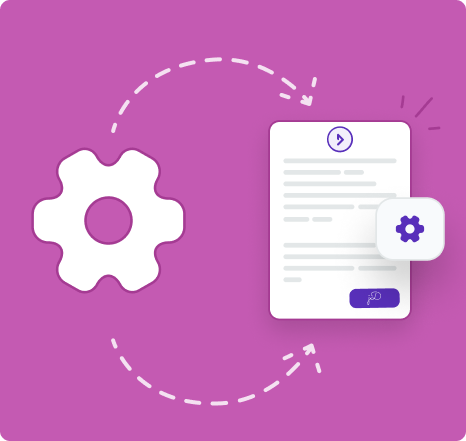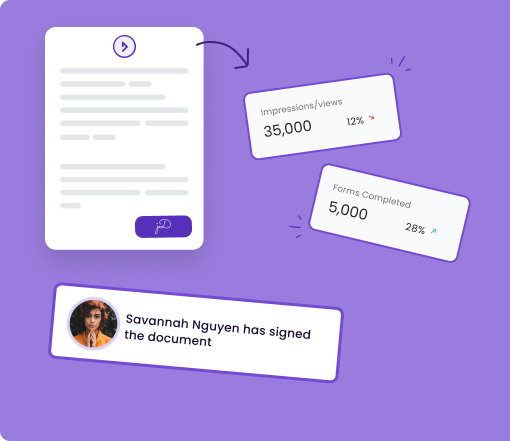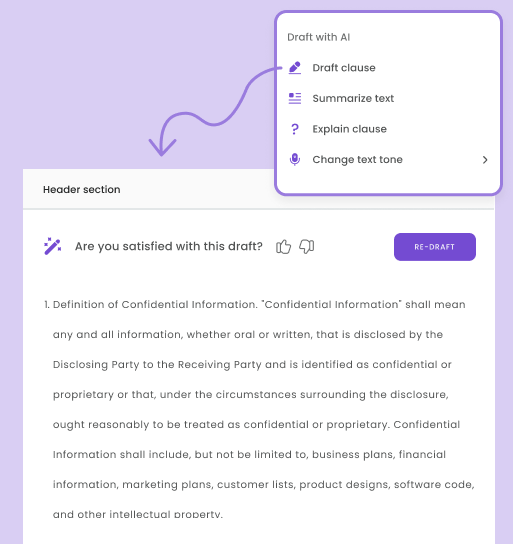We’re in the age of efficiency.
Actions at work, unless they have an outsized impact, are assessed through the lens of productivity.
This isn’t a bad thing, but if handled poorly, it can lead to diminishing quality and hidden expenses.
There’s a way to improve efficiency without sacrificing quality – business automation.
As the name suggests, business automation is using various technology to streamline, automate, or improve business processes with little to no human intervention.
The key is using the right types of business automation for your situation. In this guide, you’ll learn the types of business automation, use cases, and even the best tools for the job.
1. Workflow Automation
Automating repetitive tasks and approvals
Let’s face it — you probably have a bunch of tasks in your business that eat up time but don’t need a human touch. That’s where workflow automation comes in.
You can set up automations to handle repetitive tasks, send notifications, route documents for approval, and more.
Think of it as putting your busywork on autopilot. It frees up your team to focus on work that generates revenue, keeps customers happy, or plan more impactful initiatives.
Tools:
There are countless tools that can help you automate your workflows. Some require writing code, others are visual builders, and a few allow you to select from various options.
Zapier has a wide range of use cases and makes it simple to connect apps and trigger actions—like moving data from your CRM to your email list.
Microsoft Power Automate is a solid choice if you’re already using the Microsoft ecosystem; it lets you build more complex automations across your tools.
If you work with a lot of routine documents, DoxFlowy helps you automate document workflows like contracts, NDAs, and approvals—no manual back and forth required. This is especially useful if human error can have significant ramifications.
Use cases:
Imagine you hire a new employee. Workflow automation can handle sending welcome emails, adding them to Slack channels, and scheduling training sessions.
Or, consider invoice approvals. Instead of chasing signatures, you can automate the entire flow: route invoices to the right people, trigger reminders, and sync approvals with your accounting system.
Of course, these are just a few basic use cases. Think about what you need in your organization and how you can automate the simple or repetitive tasks.
2. Robotic Process Automation (RPA)
Using bots to handle rule-based tasks
When you have tasks that are repetitive and follow clear rules, RPA works well. Things like copy-pasting data between systems or processing the same forms over and over can be accomplished with RPA.
You can set up bots (software robots, not physical ones) to do this kind of work for you. They mimic the clicks, keystrokes, and actions a person would take. The main difference is that they do it faster, without getting tired or making mistakes.
Tools:
There are countless tools that can facilitate RPA. UiPath is one of the most popular and offers a user-friendly way to build bots without coding.
Automation Anywhere is another platform geared toward both small and large businesses.
There’s no right or wrong tool – no best option. Explore different tools and select the one that’s is the best fit for your use case.
Use cases:
Two classic places to start with RPA: data entry and form processing.
If you’ve got someone spending hours transferring data from one system to another, a bot can take over that task. Likewise, if you’re processing customer forms, RPA can read the forms, extract the data, and enter it where it needs to go.
It’s not glamorous work. With that being said, automating it can save a ton of time and free your team up for more valuable tasks.
Keep in mind that the major shortcoming of RPA is that the data needs to be structured. The format needs to be the same every time. Keep this in mind when structuring your automation workflows.
3. Business Process Automation (BPA)
Streamlining end-to-end processes across departments
Sometimes you need to look beyond individual tasks and think about the bigger picture. How does a single process move across departments, teams, or even between organizations?
That’s where business process automation (BPA) comes in. BPA helps you automate entire end-to-end workflows that involve several people, systems, and or departments.
The goal is to make your processes more efficient, transparent, and consistent while cutting out delays, reducing costs, and removing manual handoffs.
Tools:
There are countless tools that address BPA directly and indirectly. There are a few strong options.
Kissflow is a great platform that lets you automate complex business workflows without heavy IT involvement. Because of the breadth of its functionality, it can be difficult to master its advanced features.
ProcessMaker is another good choice if you need more customization and integration with your existing systems. Like RPA (which is a branch of BPA), you’ll need to structure the data you’re using to get the most out of the systems you implement.
Use cases:
Order processing is a perfect example of BPA in action.
Instead of bouncing between sales, finance, and fulfillment, you can automate the entire flow. Once an order comes in, approvals happen automatically, inventory gets updated, and invoices are generated.
Similarly, procurement management can be streamlined with BPA. Automate purchase requests, approvals, vendor selection, and order tracking. It reduces errors, speeds things up, and gives you better visibility across your operations.
4. Marketing Automation
Automating customer engagement and lead nurturing
If you’re running a small business or managing a department, chances are your team wears a lot of hats and keeping up with marketing can feel overwhelming.
That’s where marketing automation comes in. You can set up automated workflows to handle customer engagement and lead nurturing, so the right message reaches the right people.
This all happens in the background based on various factors such as website activity, email activity, purchase history, and more.
It helps you build relationships on autopilot, while you focus on running your business.
Tools:
There are countless tools that claim to provide marketing automation services. Oftentimes, they’re glorified email autoresponders that only focus on one aspect of your marketing.
Tools like HubSpot, a full-featured platform that covers email, social media, landing pages, and CRM give you the flexibility to automate your marketing across multiple touchpoints.
Mailchimp is also moving into marketing automation with its offerings like landing pages, websites, social media marketing, and deep customer segmentation.
ActiveCampaign Is one of the most powerful automation tools with a focus on email. It also touches on various areas like SMS marketing, landing pages, forms, social messaging, and much more.
Use cases:
Email campaigns are the obvious first choice for automation.
You can set up welcome emails, drip campaigns for new leads, follow-ups for abandoned carts, and more—all triggered automatically based on customer behavior.
Social media scheduling is another easy win: instead of posting manually every day, you can schedule posts in advance and automate publishing across platforms like Facebook, Instagram, and LinkedIn. It keeps your brand visible while saving you a ton of time.
5. Sales Automation
Optimizing sales workflows and customer interactions
Sales is all about relationships, but that doesn’t mean your team should be stuck doing manual data entry or trying to remember when to follow up.
Sales automation helps you streamline sales workflows and make sure customer interactions happen at the right time.
You can automate things like lead routing, scoring, follow-up emails, task reminders, and CRM updates, so your salespeople can focus more on closing deals and less on managing the pipeline.
Tools:
For sales automation, HubSpot Sales Hub is a go-to. It’s user-friendly and works great if you’re already using HubSpot for marketing.
Pipedrive is another excellent option, especially for small businesses looking for a simple but effective sales CRM with automation built in.
And if your team uses Salesforce, Salesforce Sales Cloud gives you powerful automation tools right inside the platform.
Use cases
CRM updates are one of the easiest things to automate. You can set up rules so that when a deal stage changes, the CRM updates automatically, assigns tasks, or triggers next steps.
No more “forgot to log it” moments.
Follow-up emails are another big win. You can automate thank-you emails, check-ins after demos, or reminders after a quote is sent. This helps your team stay on top of opportunities without having to track every single touchpoint manually.
6. Customer Support Automation
Using AI and chatbots for instant responses
When customers have questions, they want answers—fast. But your support team can’t be everywhere at once. That’s where customer support automation can play a major role.
You can use AI and chatbots to handle common questions and provide instant responses, 24/7.
This keeps customers happy and reduces the load on your human support staff. It’s like having a virtual assistant on your website or in your helpdesk that never sleeps.
If you go this route, be careful. Make sure it’s still easy to get in touch with real humans. You don’t want a situation where someone can’t get the help they need.
Tools:
Intercom makes it easy to add conversational chatbots and live chat to your site. Zendesk offers built-in automation and AI-driven bots that integrate seamlessly with your support workflows.
Freshdesk is another solid option, especially for small businesses. It offers chatbots, ticket automation, and even AI-powered suggestions for agents.
Use cases:
Chatbots can handle FAQs, guide customers to the right resources, or even help with simple transactions (like booking appointments or checking order status).
Meanwhile, automated ticketing systems can categorize incoming support requests, assign them to the right team member, and trigger status updates automatically. This saves time and ensures nothing slips through the cracks.
This combo gives you a more responsive and efficient support experience for your customers.
7. Accounting and Finance Automation
Automating financial processes and reporting
Everyone knows that balancing the books is a tedious but crucial task. It’s often time-consuming and detail-heavy. Easy to make mistakes.
Accounting and finance automation helps you streamline these tasks by automating everything from transaction entry to generating reports.
This not only cuts down on errors but also gives you faster, more accurate insights into your financial health so you can make smarter business decisions.
Tools:
Popular tools for this space include QuickBooks, which offers powerful automation for bookkeeping, invoicing, and payroll. It also has a wide range of integrations.
Xero is another favorite, especially for small businesses wanting cloud-based accounting with automated bank feeds and reconciliations. For expense management, Expensify makes tracking and approving expenses easy and automated, saving you from drowning in receipts.
Use cases:
Think about payroll processing. Instead of manually calculating hours, taxes, and deductions, automation can handle it all, ensuring everyone gets paid accurately and on time. For expense tracking, employees can snap photos of receipts, and automation tools will categorize and log expenses automatically. This keeps your books clean and frees your finance team to focus on higher-level strategy rather than busywork.
Conclusion
This guide has highlighted many types of business automation. Some are easy to accomplish while others will require you to overhaul the way your business works.
Whatever your goals are with business automation and the tools you choose, it’s important to start small, build expertise, and expand your automation efforts.
With this approach, you can spot issues early, minimize their impact, and correct course. All that’s left is for you to choose the type of business automation you want to implement and get started.
If you’re looking to automate document workflows, be sure to check out DoxFlowy.




